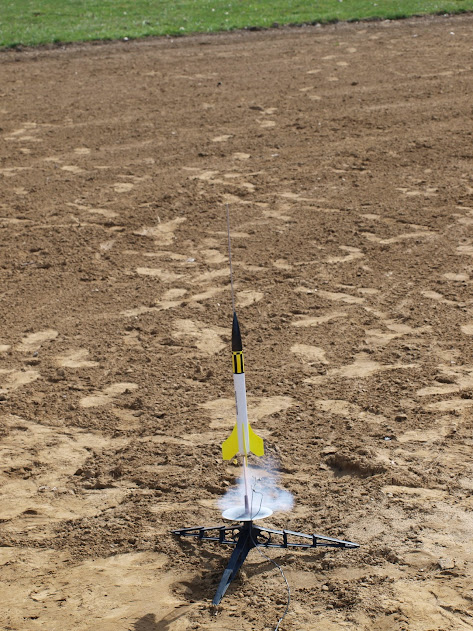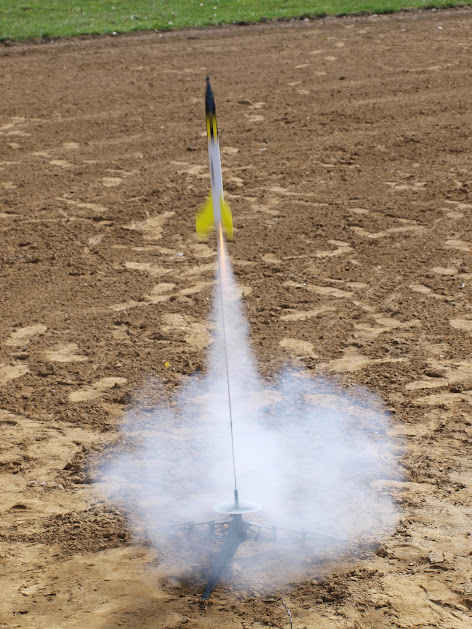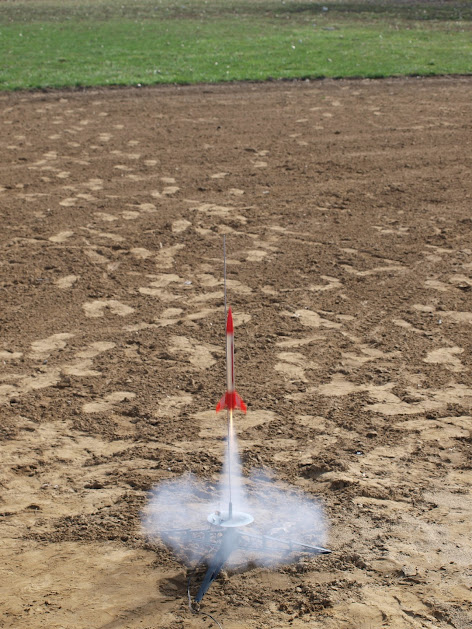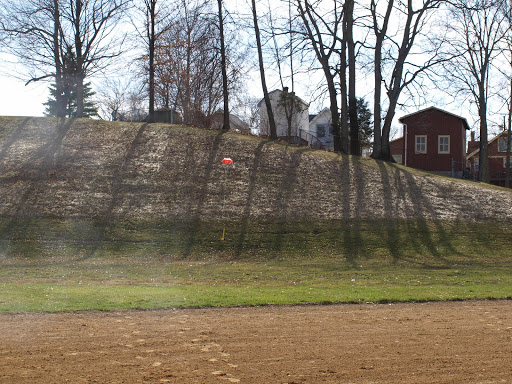No way I could have an opener at B6-4 Field without a Carl McLawhorn Memorial bird or two. In the case of this launch if would have been 1.5 with the finished Semroc Aphelion and nekkid Semroc Stellar Spartan both flying.
Quite happy with the way the Aphelion turned out, even with the massive finishing error. I wasn't 100% sure I could get the face card look that I wanted, but threw caution to the wind and dragged out my math abilities. I measured the wrap decal, transferred the measurement to the body tube, masked the area off, and laid down a perfect segment of neon yellow to match the fins.
Missed it by that much. (Holds fingers 1/2" apart.)
I knew I was in trouble when I started arithmeticing. It never ends well for me, which means I've developed a keen scrambling ability over the years. My solution? Cut the decal in half across its width, then apply the decal in a top and bottom section, taking care to line up the lines in the roll pattern. Worked like a charm, and the error probably wouldn't be noticeable if not for this blog and my big mouth. I'll pause here to allow for applause.
The flight was impressive. Smaller rocket, so an A8-3 flight, which I knew from a previous flight would be perfect for both the field and conditions. The flight was straight up, with ejection occurring at the optimal post apogee tip. The Aphelion then rode the breeze to the deepest, sloppiest corner of center field, landing without damage among the collected goose leavings. Not a fan of geese on any level, but I've never eaten one, so there's still hope.
Oh, and I should mention that I was wrong about not catching any lift-off shots on the day, as is seen above. I really need to at least prep to the point that I look at the pictures before I start writing. Yeah, that'll happen.
Speaking of memorial flights, my #6 flight on the day was one of a different kind. James Gartrell and I occasionally had night time conversations via e-mail and private message when we were churning out reviews for EMRR. James was a good man, had a cool sense of rocket history, and an eye for the seldom seen clone. I remember hearing that he had been diagnosed with cancer at some point, but I was coming back from a year-long break that had almost become permanent when I found that he had passed in my absence. Carl's passing was hard for anyone who had ever made a purchase from Semroc. James wasn't as high profile, but every bit as good a guy as Carl. Both deaths felt like family. Still do. They both had the ability to make you feel that way. After James passed I started seeing his rockets for sale on Ebay under his "Rocket Grandpa" name. I bid early and often on anything that caught my eye, the list of which would probably be good for a laugh if I'd have kept track. I bid on quite a few unbuilt kits, and an equal number of built ones. I'd almost given up hope when I landed an Estes Spitfire SSI that had been built and flown by James.

Far out, man. I vaguely remember this kit from the early part of the Y2Ks. It was one that came along in the midst of the great Estes identity crisis when they couldn't decide if they were a hobby company or a toy company. The Spitfire has the look of a toy company offering. I think I might have been the only bidder. The rocket had the look of an experienced bird, and would have even without the Estes dent in the top of the body tube. The dent had cinched it, and I was surprised to find that it had the sadly short Estes shock cord installed, which explained the aforementioned dent. I added another length of sewing elastic that had been in my range box for a while, perfect for emergencies. (Remind me to stick a pack of elastic in there before the next launch.)

This rocket was a tweener for B6-4 Field. From a size standpoint it was an A8-3 bird, but the draggy looking fins made me think it would work well as a B6-4 bird. Considering the lengthening drift that I'd been experiencing on the day, I went conservative with the A8-3. Probably for the best as it turned out. The rocket left the pad heading down the third base line, the only rocket to do that on the day. It kept a wiggly flight path the whole time, eventually ejecting in foul territory, then riding the breeze back out to recover in center field, surprisingly deep.
I earned a pat on the back for the engine choice. I think the B6-4 flight may have reached one set of trees or another.
Flight #7 was the Estes Crossfire ISX. (SSI. ISX. Were the extra letters really necessary? Couldn't the last two rockets have just been the Spitfire and Crossfire? Both were the builder of a two rocket starter kit, so maybe that has something to do with it. I'm boycotting the extra letters from here on. Rant over.) The Crossfire had been in my build pile for a while when my buddy Zog attempted to fly his to death on this very field a few years back. He kept loading it with C6-5s and TRYING to lose it. For some reason it had angered him, but even he couldn't explain why. I think he made three flights with the Crossfire that day, all three straight up and straight down. By the end of the day he admitted that he'd gained a new respect for the rocket. As had I. With this in mind, I loaded mine with an A8-3 for the first flight.


After the wiggly flight of the Spitfire, the Crossfire was a welcome sight, tracking straight and true through the whole flight. The breeze carried it out toward the outfield at an alarming rate, and at first I thought I might do with mine on an A8-3 what Zog had failed to do on a C6-5. It wound up deep in dead center, then began racing toward right, flirting with the trees the whole time. In the end it recovered deeper than any flight had all day, and actually wound up on the hill. I uncinched. Seriously. Thought it was a goner.

Flight #8 was the Estes Firehawk, which brings me to another rant. WHY DOES ESTES HAVE TO RECYCLE NAMES????? We already had a Firehawk, a perfectly cool BT-60 bird. Why sully the name by sticking it indiscriminately on a plastic, no paint needed, disposable rocket? End of rant #2. That said, the new Firehawk was a rocket I picked up at Hobby Lobby from the clearance rack when I was in Cleveland for NARAM 55 two years ago. My nephew was due in town and I wasn't sure if Tony and I were going to be taking him to the range with us, so I needed something that he could build quickly and fly without worrying about its future. The $4 Firehawk fit the bill nicely. As it turned out, John never went to NARAM, and I had to leave early to take my Mom to a funeral. The Firehawk came home with me and got stuck in the build cabinet. Then one night over the winter when I was bored, I decided that I needed something to distract me from another library movie that my wife had brought home, and the Firehawk fit the bill. I had it done in under an hour, and in the end, I was fairly impressed with how good it looked. The plastic fin can and motor retention didn't seem long for this world, but at least they'd had the forethought to include two of the rings.

Flight was on a 1/4A3-3T, so it was quick. I was surprised to find that I captured the liftoff. I turned to look skyward after it left the rod and almost immediately heard and SAW the ejection charge. A ball of flame burst out of the front of the rocket and the sound was far an away the loudest of the day. I know it was also one of the closest to the ground, but the blast was significantly louder than any of the others. I thought I saw the rocket fall to the ground in more than one piece, but it was all together when I got to the landing site in short right.
That doesn't mean that all was well. The top of the motor had been turned to ash when I pulled it from the rocket. It was charcoal to about 1/16" and just crumbled when I touched it. The clay nozzle was still there, so it didn't seem to have CATO'd, but it was a heck of an ejection charge. No wonder my 220 Sprint disappeared into the ether last year.
The last flight of the day was the Semroc Stellar Spartan on an A8-3. I didn't start out with the idea of it being the last. I still had several rockets in the box, but the winds were picking up noticeably.
This is another perfect rocket for the A8-3 on this field. Flight was straight and fairly high. Ejection occurred at the normal time and the rocket began racing across the field with the breeze. I kept firing, all the while thinking how much it reminded me of the recovery path my Astron Drifter clone had taken two years ago before hanging itself up on the wire. I cinched up again.
Things looked grim, and I initially thought it might have landed in the street. I quickly walked up to retrieve it and didn't see it anywhere. That was when I looked to my right and noticed it in the side yard of the house at the top of the hill. As you can see, a good distance from the launch site, (now more of a no-man's land that I look at it, not a pitcher's mound setup.) That was enough to convince me. My day was done, and everything was going home with me. Another small field success story.










































